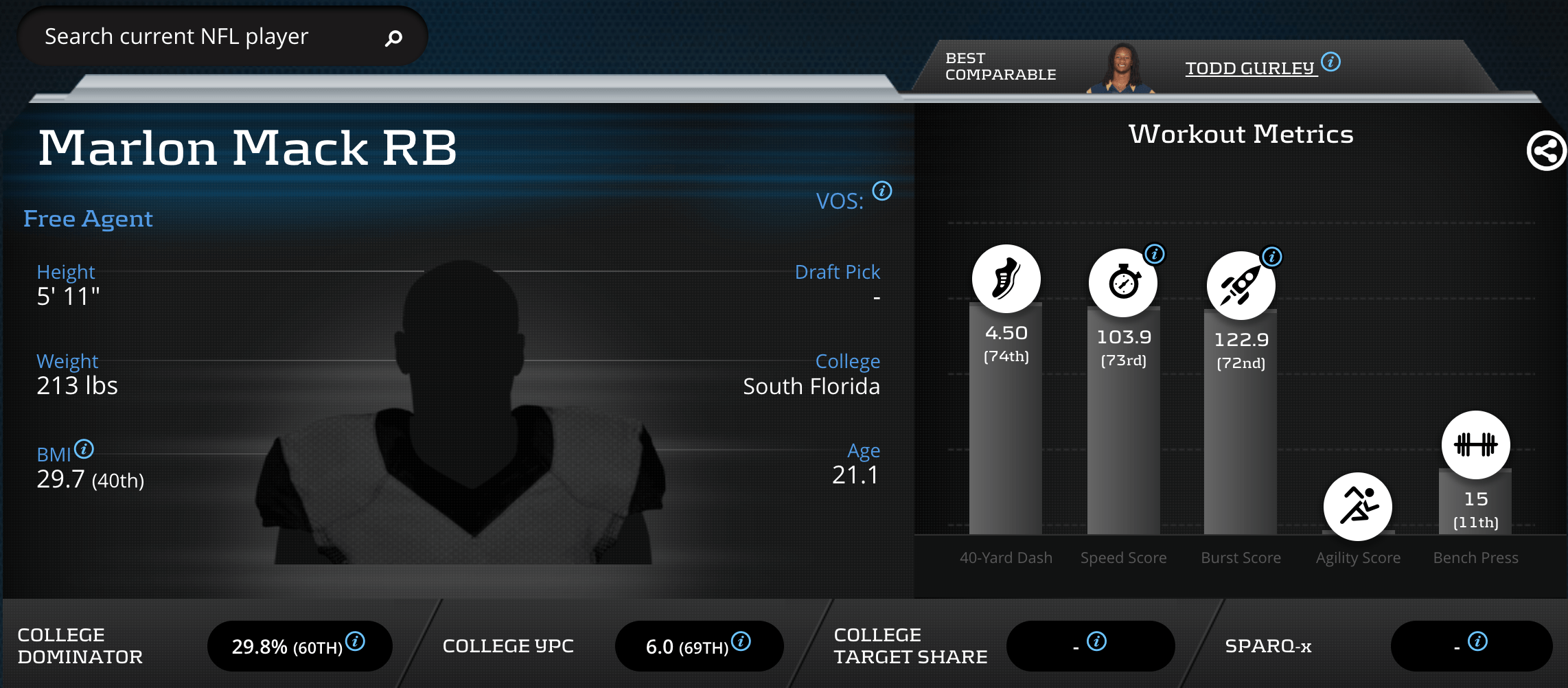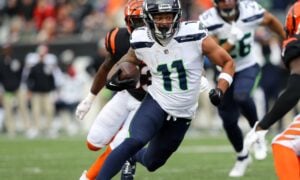Rookie Profile: Marlon Mack, RB South Florida
Despite sustained success at the immediate beginning and ending of his collegiate career, Marlon Mack has slipped under the radar to a drastic degree in NFL Draft coverage. For three years, he was one of college football’s most explosive and entertaining backs. Now, entering the NFL, he offers immense promise if allowed to mature in a good organization.
[am4show have=’g1;’ guest_error=’sub_message’ user_error=’sub_message’ ]

Mack didn’t take long to accustom himself to the college ranks. At 18 years old and playing in his first game out of high school, the freshman gashed Western Carolina for 275 rushing yards and never looked back. Running behind one of the statistically-worst offensive lines in college football, he finished the season with a fair clip of 5.2 yards on his 202 carries.
In his sophomore year, accompanied by a rejuvenated passing attack and much-improved offensive line play, the Bull broke out, raising his efficiency mark to a cool 6.6 yards per carry. Quarterback Quinton Flowers had yet to fully develop, allowing for Mack to be the lead dog in the USF offensive attack and gain 1,381 yards on the ground, the highest total in his conference.
As Marlon’s junior season came along, so too did coach Willie Taggart’s offense. Flowers blossomed and formed a devastating one-two punch with Mack, leading to one of college football’s best and most explosive offenses. Flowers saw his role in both the passing and rushing games increase, so Mack actually ran the ball the least in his senior season. The drop in volume didn’t hurt his play, however, as he once again improved upon his previous season’s YPC mark. He also showed more promise in the passing game, catching a little more than two passes per game.
Through three turbulent USF seasons that saw the Bulls’ record go from 4-8 to 11-2, Marlon Mack was the one constant. His play steadily improved despite varying degrees of offensive involvement. He finished his career atop the infantile American conference in career rushing after three consecutive seasons over 1,000 yards.
On the Field
Marlon Mack might be this rookie class’s most thrilling back to watch. He is certainly not the best, but can catch everyone off-guard with huge plays unlike any other back. In 2016 alone, he scored six touchdowns from at least 43 yards out. He takes off with maybe the best burst in the class, and pulls away from any defender he has already passed.
He puts solid vision to good work, identifying most holes quickly once they open and blasting through once he’s reached them. Mack has even shown the ability to anticipate holes developing at points. He’ll generally display patience behind his blockers if he hasn’t found anything to work with yet.
As he shifts from scanning for holes to attacking them, he uses impressive agility and quickness, which allow him to make it almost anywhere he wants to go. He navigates his blockers well from side-to-side and there are select plays where he just looks quicker than every other player on the field. Simply put, you can rely on him to make it to his spot if he’s found it.
On the other hand, there are definite, easily-identified concerns with his game. His patience is there, but he encounters problems without holes both on the outside and inside. He waits too long for holes to develop at times where he should ditch hesitancy and charge upfield for as many yards as he can get. On sweeps, if there’s not a clear lane for him to cut up, he will always run to the sideline. Even when running off-tackle, he’ll take his chances going East-West instead of North-South if the choices appear about even. This decision worked for him a fair amount in the American, but won’t be nearly as successful in the pros. These tendencies point to a larger immaturity in Mack’s running style.
One of my football coaches’ favorite motto was “play smarter, not harder.” Mack does the opposite. When not waiting for a hole to open, he’s always playing full-speed. As a result, he stumbles over himself all the time. He often slips when switching directions and jumps too far when cutting. He embraces contact, but his “strategy” when approaching tacklers is little more than “get low and dive into their knees.” Playing hard is no problem, of course, but he needs to learn to tone it back.
The good news is that he has developed in one of these areas of weakness already. In his first two seasons, Mack went down at first contact almost all of the time. He ran too fast to change directions and use elusiveness and had yet to develop much balance at all. However, in his senior season, Mack made strides. He showed the ability to shift it back a gear, juke a defender (or, simply change angles) and reach the open field, where he would’ve been brought down by a defensive back before. He also showed nice flashes of balance, absorbing contact on different spots of his body and pounding on.
In the future, I want to see him work on his running strength and ball security too. He’s built well, and should be able to generate solid power with his body alone, but broke very few tackles with strength in college. As can be seen in virtually any video of his, he does not satisfactorily cradle the ball, as he often keeps it away from his body and looks quite uncomfortable carrying with his left hand.
By the Numbers

Obviously, the Todd Gurley comparison pops off the screen when viewing his Player Profiler page. Both backs boast pretty-good speed scores and 40 times, but the comparison largely ends there. Mack plays as much more of a speed back, whereas Gurley utilizes a great balance of tools. When looking at his scores alone, he doesn’t strike you as the type to simply outrun defenses, but he plays as fast in pads as he runs in drills while his opposition slows down a bit.
It’s a shame that Mack didn’t participate in any shuttle or cone drills, but you can still glean some information from his combine testing, shown here from his Mock Draftable page. His broad jump displays the explosiveness he plays with in moving from first to second gears. His 40 time isn’t spectacular, but shows that he certainly won’t be caught from behind.
Overall
Marlon Mack could blow up in the NFL, but he’s not being treated with such potential in the draft community. He’s often the quickest player on the field with vision requisite to maximize what his offensive line provides for him. However, “rough around the edges” would be an understatement in describing Mack: He has a lot of things to work on.
If he falls into a situation with proper coaching and development, though? In such a scenario, he can fix his style, improve his strength and become an absolute terror. A lot boils down to landing spot, but with Mack currently ranking in my top ten rookie backs, I’ll sign up for him wherever I can get him at his current ADP. Even without a developmental breakthrough, he’s still a thrilling prospect to watch and have in your lineup from time to time.
[/am4show]
- 2024 Rookie Drafts: Running Back Tiers Primer - May 10, 2024
- Dynasty Fantasy Football: Surprise Undrafted Players in the 2024 Class - May 2, 2024
- 2024 Dynasty Fantasy Football Rookie Drafts: A View from the 1.03 - April 21, 2024


































































